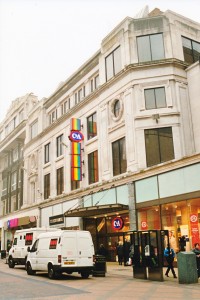
C&A in Bristol in 1999. (K. Morrison)
Despite adding a bright splash of primary colour to British high streets, with its rainbow logo and blue/red oval badge, C&A gained a reputation for selling rather dowdy clothes. An association with cheap polyester haunted the company from the 1970s, and efforts to reach out to the young and fashion-conscious generally backfired. The company withdrew from the UK in 2001, but continues to thrive in Europe.
C&A left a legacy of store buildings which shoppers still visit on a regular basis. Founded in the 19th century by Roman Catholic textile dealers (Clemens and August Brenninkmeyer) from the German-Dutch border area, the company entered the British market with a splash when it opened close to Selfridge’s on Oxford Street (‘Bird Street’) in 1922.
C&A specialised in outerwear for ladies, maids and girls. Within a few years, however, the word ‘maids’ was dropped from C&A’s advertising and millinery had become an important new line (hence the nickname Coats’n’Ats). When a second London branch opened in the old Hyam’s building on Oxford Street in 1925 it was briefly called ‘Canda’, just in case the market could not sustain two C&A branches so close together. But that pretence was dropped in 1927.

C&A’s shopfront in Liverpool, made by Parnall & Sons in 1924. (K. Morrison)

C&A in Liverpool, photographed in October 2000
The first provincial branch opened in a wing of Woolworth’s new development in Liverpool in 1924. Interestingly, C&A’s architects, North, Robin & Wilsdon, had previously designed several stores for Woolworth’s. The common factor was the commercial estate agent Hillier, Parker, May & Rowden, who found premises for both firms and maintained a close professional connection with North, Robin & Wilsdon.
In 1929 North, Robin & Wilsdon remodelled an old building in Leeds for C&A with the aid of a (sadly unidentified) ‘famous French architect’. The elevations were updated with art deco touches, including triangular-headed windows – a feature repeated on an office block at 2-4 Dean Street, Soho, London, designed in the same year by the same architects with Considère Construction Ltd.
The shopfront of the Leeds store was given a broad marble surround that lent a modern Parisian air. All of C&A’s shopfronts were in the form of arcades which penetrated deeply into the ground floors of the stores and were lined by extensive display windows populated by carefully lit mannequins. These arcades were created by the country’s very best shopfitters, including Parnall & Sons and Fredrick Sage & Co. Interiors were entrusted to Elliott’s of Reading.

C&A’s arcade shopfront in Manchester, c.1928 (Shaws of Darwen)

As a child I we always thought it was coats n ats. That is what my grandmother told me!!
LikeLiked by 1 person
I was one of the Shopfitting Apprentice Joiners who worked on the Ilford branch of C &A Modes, 1960 ish
LikeLike
What company were you apprenticed with Anthony? I know C&A often used Elliotts.
LikeLike